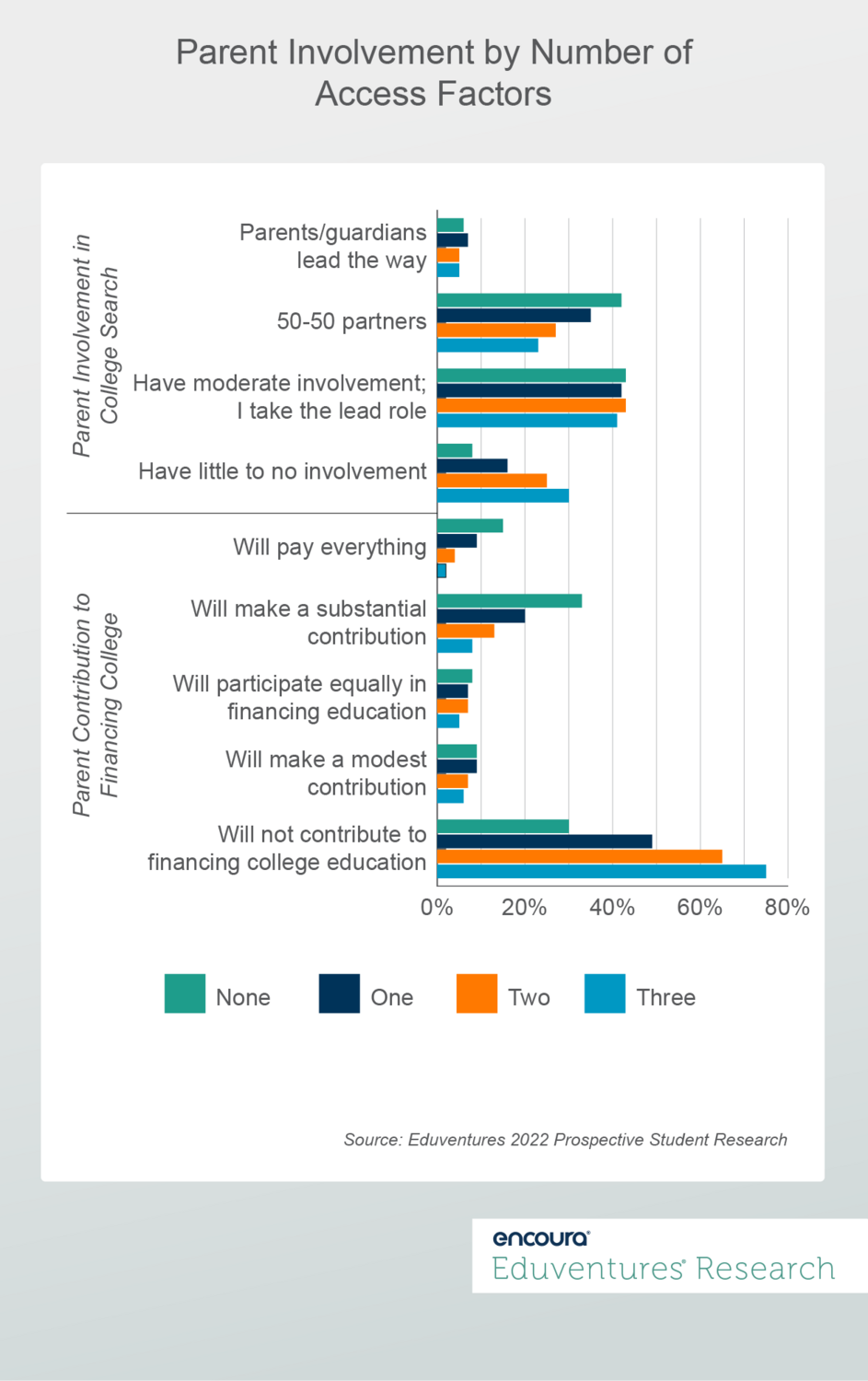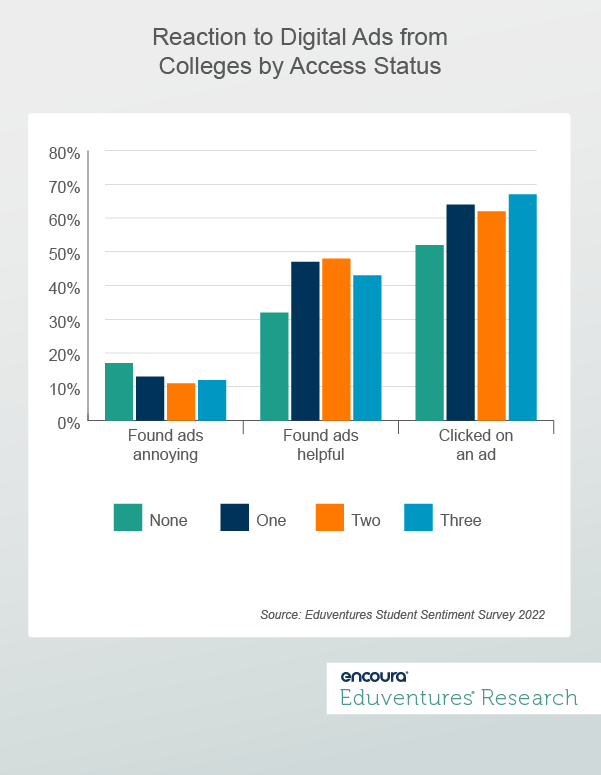“Who is your main competitor?” asked an Encoura colleague during a recent campus visit at a regional state university. The answer—Target—was surprising but relatable. With declining enrollments, primarily at community colleges (-7.8% decrease in spring 2022 alone) and public four-year colleges (-3.4%) and a strong labor market, it is easy to see why underserved student populations, a key student segment for these schools, might choose unskilled labor over education.
So, how can we get their attentions to bring them back into the fold?
Access and Obstacles
Previous analysis of Eduventures’ Prospective Student Research™ has revealed a 20% decline in the number of first-generation students, an 11% decline in the number of underrepresented minority students, and a 7% decline in low-income students in the college-bound pipeline. We often refer to students who fall into one or more of these categories as “access students.”
It is not only the favorable job market that causes access students to reconsider their higher education plans. The students who are still in the college pipeline face obstacles that make their college searches more challenging than that of students without these factors.
Eduventures’ Prospective Student Research reveals two key elements that contribute to student struggles: lack of parental support in college search, and financial uncertainty.
Figure 1 shows student expectations of parental involvement in their college journeys segments by the number of access factors (one, two, or three).

Figure 1 shows that as the number of access factors a student has increases, the expectation of parental support in college planning falls. This is particularly true for financial support. In fact, 65% of students with two access factors and 75% of those with all three access factors believe their parents will not contribute at all to financing their college educations.
While financial support is likely a significant factor in college success, institutions shouldn’t discount the less tangible support that parents provide by guiding students through the college search process. Eduventures' Prospective Parent Research™ reveals that parents take on many roles in college search and are pivotal in motivating and coaching students through this daunting process, which can make a big difference.
Because of this, Eduventures has long emphasized the importance of including the whole family in student recruitment. But what can institutions do when parents are not able to help, and students are on their own?
Students with all three access factors, as our parent research further shows, are indeed engaging in fewer college search activities on average than other students. This indicates that access students may have less information available to inform their decision making. Perhaps, they are also less aware of specific institutions, and what these institutions could do to support them through their search processes.
How can schools get these students’ attention, both those struggling with their searches and those who have given up on higher education for now? Eduventures' Student Sentiment Research™ suggests that the answer may be quite straightforward.
Figure 2 illustrates prospective students’ reactions to institutional digital advertising.

Students with access factors, the data shows, have more positive views toward digital ads from colleges and universities and are more likely to click on an ad than students without these factors. It is interesting to note that students with all three access factors are somewhat less likely to find digital ads helpful and informative compared to those with just one or two factors. They are, however, more likely to click on an ad.
This means that access students – who have less support in their immediate environment and are less active in search – are the most likely student segment to pay attention to an institution’s advertising.
Related to these findings, prior research has shown that students of color, in particular, are more likely to use social media in college search. This provides an opportunity for institutions to not only engage the students who are actively searching, but perhaps also recapture the attentions of students who have given up on academic dreams if the messaging is on target.
The Bottom Line
, but institutions still need to be strategic about their ad campaigns.
There are three critical steps to be most effective:
- Targeting students: Your ads won’t be impactful if they are not served to the right students. To ensure you are reaching your target audience you must not only know them well, but you must know where they are, physically. Geofencing popular workplaces—like Target—or using custom audience targeting based on online behavior will likely yield results. Residential geofencing can also boost your exposure and even engage their hard-to-reach parents.
- Piquing their interests Underserved students need to know that higher education still is an option for them; that it is both affordable and worthwhile. Ads targeting these students need to have messaging that addresses these concerns.
- Helping them over the finish line: Once a student clicks on an ad, you want to make sure it directs them to information that is relevant and helpful. Rather than directing them to your website’s homepage, send them to pages that are designed to provide them the information they need to succeed.
Remember, these students have less support in their searches. You need to ensure that you are prepared to provide not only the information they need, but also the extra support they require to apply and enroll.
Never Miss Your Wake-Up Call
Learn more about our team of expert research analysts here.
Eduventures Senior Analyst at Encoura
Contact
Over the past three years, Eduventures has developed a behaviorally and attitudinally-based market segmentation of college-bound high school students we call Student Mindsets™. This year, the sample of nearly 40,000 respondents was drawn from the myOptions® database of college-bound high school juniors and seniors as well as institutional inquiry lists, allowing us to refine and validate the Mindsets in a national sample of unprecedented breadth and depth.
These market “Mindsets” get at students’ imagined paths through college by assessing the desired outcomes of college, perceived importance of college experiences, and key decision criteria at time of application.
The fundamental purpose of the Eduventures Prospective Student Research is to help institutions better understand how college-bound high school students approach one of the most important decisions of their young lives. For a teenager, the college decision looms as a complex make-or-break moment, a pivotal turn on an imagined path to adulthood.
How you engage with prospective students and their families needs to evolve with emerging media trends. As a team of experienced enrollment leaders, we work in tandem with your traditional engagement methods and provide targeted digital media strategies to help you navigate the ever-changing digital landscape.
